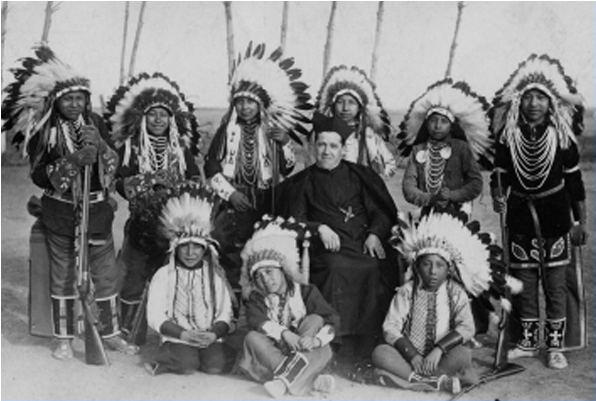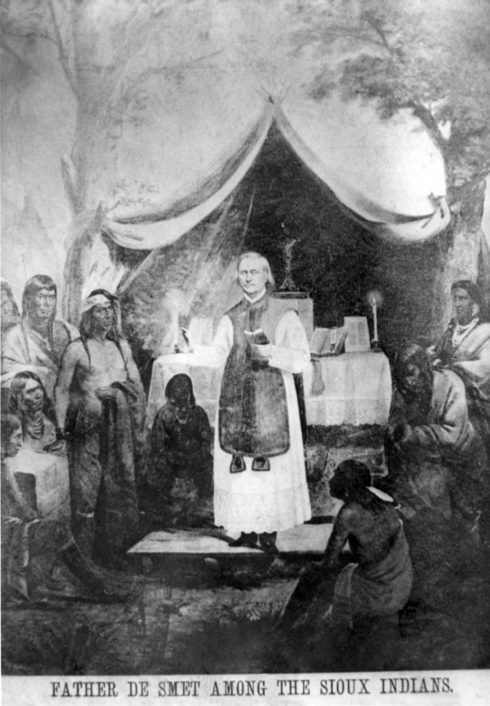After crossing the Bitter Root Mountains he came to the country of the Coeur d’Alènes, a fertile, lovely valley stretching westward hundreds of miles. Clusters of dark pines and cedars emerged from the green plain, in the center of which lay a lake well stocked with fish. A river ran through the valley, and to the north, east, and south, snow-capped mountains pierced the clouds. Formerly the Coeur d’Alènes were considered the most barbarous and degraded of the mountain tribes; they adored animals, and lived in complete ignorance of God, the soul, and a future life. Even the precepts of natural law were but vaguely understood and pretty generally offended against in practice. About 1830, an Iroquois Catholic, it is supposed, taught them the first elements of Christianity. Shortly after this date, the tribe suffered the ravages of a violent eipdemic. When the plague was at its height, a dying man heard a voice saying: “Leave your idols, adore Jesus Christ, and you will be cured.” He obeyed, and was restored to health. Then, making a tour of the camp, the restored man related what had taken place and entreated his stricken brethren to follow his example. They did so and all likewise were cured.* This event produced a profound impression on the Coeur d’Alènes, but without a priest to further instruct them a few of the tribe returned to the worship of idols; the conduct of many, however, since the revelation of the true God, had remained irreproachable.

Bitterroot Mountains, located in the panhandle of Idaho and westernmost Montana in the Northwestern United States.
Such was the condition of the Coeur d’Alènes when Father De Smet visited the tribe in 1842. “I was conducted in triumph to the lodge of the chief,” he tells us, “and there, as in every other Indian camp, the calumet was brought forth. After it had been handed around several times and smoked in solemn silence the chief addressed me in the following words:
“‘Black Robe, welcome to our country. Long have we desired to see you and be enlightened by your words. Our fathers worshiped the earth and the sun. I remember distinctly the day we first heard of the one and only true God. Since then it is to Him we have addressed our prayers and supplications, and yet we are much to be pitied. We do not know the teachings of the Great Spirit, and we sit in darkness. But now I hope you have come to bring us light. I have finished. Speak, Black Robe! Every ear is open and eager to hear your words.’
“During the two hours in which I spoke to them of salvation and the end of man, absolute silence and stillness reigned. The sun was just setting, and I recited the prayer I had some days before translated into their tongue. Refreshments were then offered, consisting of scraps of dried meat, a black moss cake that tasted like soap, and a glass of river-water, all of which were as nectar and ambrosia to a man who had not tasted food since sunrise. The chiefs expressing a desire to hear me again, I continued to instruct the tribe until far into the night, pausing every half-hour to hand around the calumet and give time for reflection. During these pauses the chiefs conversed about what they had just heard, explaining it to their subordinates.
“Upon awakening in the morning I found my tent invaded by Indians who had slipped in before dawn. Getting up at once, I knelt down, the Indians following my example, and together we offered our day and our hearts to God. ‘Black Robe,’ said the chief, ‘we came here early this morning to watch you and imitate you. Your prayer is good, and we wish to adopt it. But you will stay here only two nights, and we have no one to teach it to us.’ I rang the bell for morning prayers, and promised the chief they all would know the prayer before my departure.”

A priest with the Indians. Photo from Bureau Of Catholic Indian Missions – Catholic Missionaries To Native Americans.
Then it was that Father De Smet laid down the method that would henceforth be used for teaching the tribes their prayers. He assembled the Indians, ranging the children in a circle, with instructions to keep the same place at every reunion. Then each one was made to learn a phrase of the prayer by heart. Two children repeated the Hail Mary, seven the Our Father, ten the Commandments, and twelve the Apostles’ Creed. After repeating to each child his particular phrase until he knew it by heart, the missionary then made them recite the phrases each in turn. This made a continued prayer, which the tribe listened to night and morning. After a few days one of the chiefs knew all the prayers by heart, and from that time he recited them for the tribe.
Two days after his arrival at the Coeur d’Alène camp, Father De Smet baptized the children, the sick, and the old men and women of the tribe. It seemed as though God had only kept these last on earth to accord them this supreme favor. In listening to their expressions of joy and gratitude one seemed to hear again Simeon’s praises to the Lord.
Torn with regret, the missionary took leave of his new Christians, promising to send them a priest to complete their instruction. “Never has a visit to the Indians given me so much consolation, and nowhere have I seen such unmistakable proof of true conversion, not even excepting the Flatheads in 1840.” The future but confirmed his judgment, for the Coeur d’Alènes remained, the most industrious and Christian of the mountain tribes.
* Father Point, who relates this fact, adds: “I heard the above from the lips of the Indian to whom it happened, who wept tears of gratitude in relating it. Furthermore, eyewitness confirmed his statement.” (See De Smet, “Missions de l”oregon,” p. 243; Father Point, Recollections of the Rocky Mountains in “The Woodstock Letters,” 1883, p. 153.
E. Laveille, S.J., The Life of Father De Smet, S.J. (1801–1873), trans. Marian Lindsay (New York: P. J. Kenedy & Sons, 1915), 142–4.
Short Stories on Honor, Chivalry, and the World of Nobility—no. 805











